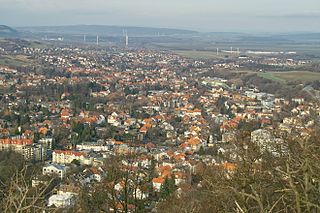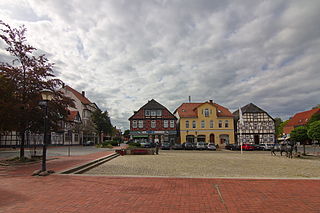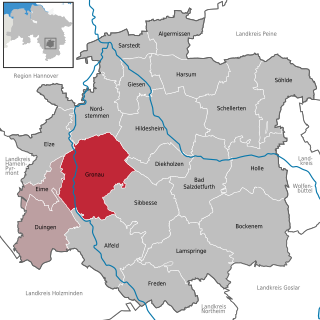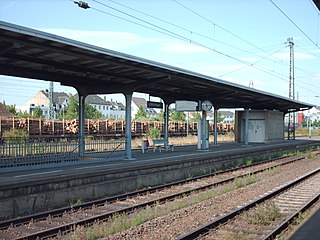
Gifhorn is a town and capital of the district of Gifhorn in the east of Lower Saxony, Germany. It has a population of about 42,000 and is mainly influenced by the small distance to the more industrial and commercially important cities nearby, Brunswick and Wolfsburg. Further, Gifhorn is part of the Hanover-Brunswick-Göttingen-Wolfsburg Metropolitan Region. The Municipality Gifhorn includes the villages of Gamsen, Gifhorn, Kästorf, Neubokel, Wilsche and Winkel.

Northeim is a town in Lower Saxony, Germany, seat of the district of Northeim, with a population of 30,118 as of 31 December 2023. It lies on the German Half-Timbered House Road.

Peine is a town in Lower Saxony, Germany, capital of the district Peine. It is situated on the river Fuhse and the Mittellandkanal, approximately 25 km (16 mi) west of Braunschweig, 27 km (17 mi) northeast of Hildesheim, and 40 km (25 mi) east of Hanover.

Bad Fallingbostel is the district town (Kreisstadt) of the Heidekreis district in the German state of Lower Saxony. Since 1976 the town has had a state-recognised Kneipp spa and has held the title of Bad since 2002. It has close ties to Walsrode, a few miles to the west. Until 2015, there was a British Army base in Bad Fallingbostel, It also hosted Defender 2020, the largest US Army/NATO exercise since the Cold War. The town has around 11,000 inhabitants.

Bad Harzburg is a spa town in central Germany, in the Goslar district of Lower Saxony. It lies on the northern edge of the Harz mountains and is a recognised saltwater spa and climatic health resort.

Wietmarschen is a unitary municipality (Einheitsgemeinde) in the district of Grafschaft Bentheim in Lower Saxony, Germany. It is split into the villages of Wietmarschen, Füchtenfeld, Schwartenpohl, Lohnerbruch, Nordlohne and Lohne with Lohne being the biggest and having the town hall while Wietmarschen, which is the second biggest, having the name.

Loxstedt is a municipality in the district of Cuxhaven in Lower Saxony, Germany. It is situated south of Bremerhaven.

Wittingen is a town in the district of Gifhorn, Lower Saxony, Germany. It is about 30 kilometres (19 mi) northeast of Gifhorn, and 30 kilometres (19 mi) southeast of Uelzen.

Liebenburg is a municipality in the district of Goslar, in Lower Saxony, Germany.

Coppenbrügge is a municipality in the Hamelin-Pyrmont district, in Lower Saxony, Germany. It is situated approximatively 15 km east of Hamelin.

Gronau is a town and a municipality in the district of Hildesheim, in Lower Saxony, Germany. It is situated on the River Leine, approximately 15 km southwest of Hildesheim, and 35 km south of Hanover. Since 1 November 2016, the former municipalities Banteln, Betheln, Brüggen, Despetal and Rheden are part of the municipality Gronau.

Bad Iburg is a spa town in the district of Osnabrück, in Lower Saxony, Germany. It is situated in the Teutoburg Forest, 16 km south of Osnabrück.

Ritterhude is a municipality in the district of Osterholz, in Lower Saxony, Germany. It is situated on the river Hamme, approx. 6 km southwest of Osterholz-Scharmbeck, and 13 km northwest of Bremen.

Burgdorf is a town in the Hanover Region, in Lower Saxony, Germany. It is situated approximately 22 km northeast of Hanover. Until 1974, Burgdorf was the capital of the Burgdorf district. The town and its surrounding areas are known for the tradition of growing white Asparagus and for breeding Hanoverian horses. Burgdorf hosts a monthly horse market from April to September every year.

Pattensen is a town in the district of Hanover, in Lower Saxony, Germany. It is situated approximately 12 km (7 mi) south of Hanover.

Springe is a town in the district of Hanover, in Lower Saxony, Germany. It is situated near the Deister hills, 22 kilometres (14 mi) southwest of Hanover.

The Hildesheim–Brunswick line is a 43 km long electrified main line railway in the German state of Lower Saxony. It forms part of the Intercity-Express route from Frankfurt to Berlin. It is also used as a diversion route from the Hanover–Brunswick line. It is a single track line from Hildesheim to Groß Gleidingen. A proposal to duplicate the line was included in the Federal Transport Infrastructure Plan of 1992.

Löhne (Westfalen) station is in the city of Löhne in the northeast of the German state of North Rhine-Westphalia. It lies on the Hamm–Minden railway, which is part of the Cologne-Minden trunk line that was originally proposed by Friedrich Harkort as part of a line from Berlin to Cologne via Hanover.
The Elze–Löhne railway is a non-electrified line from the town of Elze in the German state of Lower Saxony via Hamelin and Rinteln to Löhne in North Rhine-Westphalia. It runs between the Weser and the Weser hills from Hamelin to Bad Oeynhausen and as a result this section is also called the Weser Railway.

Nordstemmen station is located on the Hanover–Göttingen railway and the Hildesheim–Löhne railway in the town of Nordstemmen in the German state of Lower Saxony. The station building, constructed by Conrad Wilhelm Hase between 1853 and 1854, has not been used by Deutsche Bundesbahn nor Deutsche Bahn since 1977. Since 2011, the Hildesheim contractor Dirk Bettels has tried in vain to acquire and rehabilitate the grade II heritage-listed station building with public funds. Construction work begun by Dirk Bettels was discontinued at the end of March 2013 because no contract had been signed by Deutsche Bahn.

























